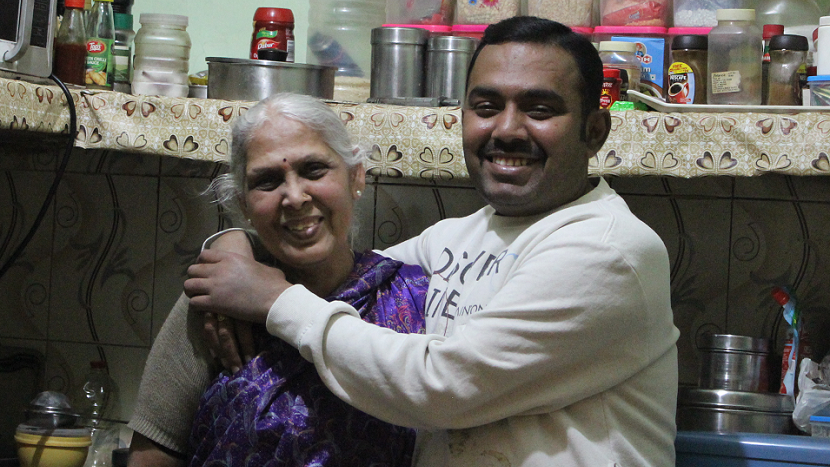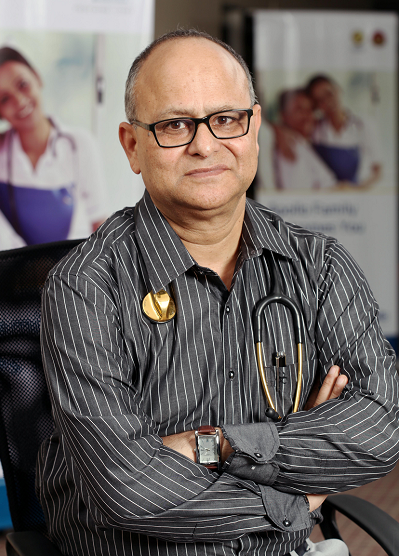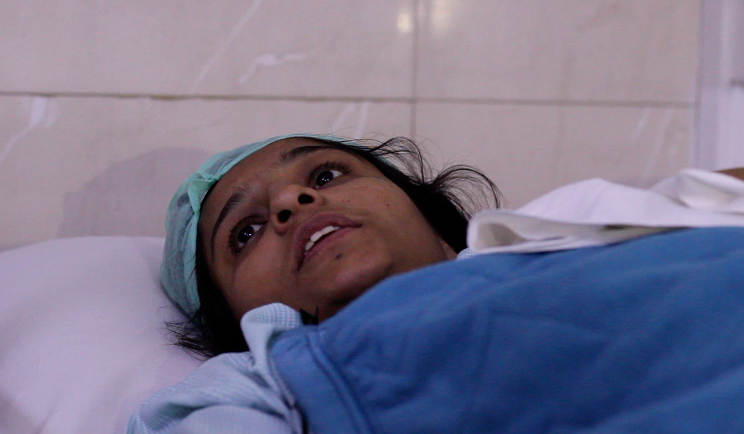
Piyush Akshay with his mother
Piyush Akshay, 34, underwent a third kidney transplant this January and is recovering well at his home in Bhajanpura in east Delhi.
His first transplant was 15 years back. His mother had donated one of her kidneys to him. It was undiagnosed, uncontrolled blood pressure that had led to a sudden kidney failure in 2003, bringing his life to a halt. “It was a hot summer day and I was on my way to office. Suddenly, I felt dizzy. I thought it could be because of simple dehydration,” says Piyush. “But we were shocked when the doctors told us that both my kidneys had stopped functioning.”
He has since been on dialysis several times between his transplants. “My complacency with regard to medicines and diet was responsible for the failure of my earlier transplants,” says Piyush. “When on dialysis, I used to feel fatigued. My right arm, where a fistula was created for dialysis, swelled. I also contracted hepatitis C,” recalls Piyush. He gasped as he reached for a glass of water on the table before him. “When on dialysis, I was allowed to drink only one litre of fluids in a day, but now I can drink as much as I want.”
The difficult period also offered him moments of joy. He met Nitu, his wife, a type-1 diabetes patient who used to come to the same dialysis centre. “The staff at the dialysis centre didn't take much time to understand what was going on between us and would often facilitate our conversations by allotting us beds next to each other,” says Nitu, who also underwent a kidney transplant. Her mother was the donor.
While Piyush is extremely lucky to have found three live kidney donors, not everyone needing a transplant is. In India, approx 2,75, 000 patients need renal replacement therapy -- either dialysis or transplant -- but only 4 percent get a kidney donor.
Seventeen in hundred people in India have some form of kidney disease. An ineffective treatment can lead to partial or complete failure of the kidneys over a period of time. Patients with kidney failure require either dialysis (a process through with the waste from the blood is removed with the help of a machine), or a kidney transplant.
Seventeen in hundred people in India have some form of kidney disease. An ineffective treatment can lead to partial or complete failure of the kidneys over a period of time. Patients with kidney failure require either dialysis or a kidney transplant
In India, only 1-2 percent people donate their organs after death as compared to more than 85 percent in western countries. And so most kidney transplants involve a live kidney donor, generally somebody related to the patient.
The cause and effect
Though there are many causes for chronic kidney disease—diabetes, uncontrolled high blood pressure, polycystic kidney disease, chronic glomerulonephritis, stones, recurring urinary tract infection -- diabetes and hypertension account for around 40-60 percent cases.
 Dr S K Wangnoo
Dr S K Wangnoo
Ten-fifteen percent patients who have diabetes or hypertension or both suffer from end-stage kidney disease and require a transplant. Piyush, for example. Similarly, Kapil Anand, 39, who recently underwent a transplant at Apollo Hospitals, New Delhi, was diagnosed with hypertension 4-5 years back. His wife, Shubi, 32, has donated one of her kidneys. “ Somehow we did not take his high blood pressure seriously. We never thought it could lead to kidney failure,” says Shubi.
Diabetes, another major cause of kidney disease and renal failure, afflicts over 70 million people in the country. Indian population already is at a greater risk of developing diabetes because of their genetic predisposition. Other factors such as obesity, stress, adulterated food, environmental pollution have added to the already high incidence of the disease. "The fast-changing lifestyle of Indians has caused a spurt in the type-2 diabetes cases in the country. Besides, adulterated food and environmental toxins kill many useful bacteria that usually thrive in our intestine and protect us from various metabolic diseases,” says Dr S K Wangnoo, senior consultant, endocrinology, Indraprastha Apollo hospital.
Doctors say that diabetics are 2-3 times more prone to renal failure. Diabetes is a complex disease; if not managed properly, a person may suffer from frequent fluctuations in blood sugar levels that can affect the kidneys adversely. Once the kidneys’ functions get affected, the creatinine and urea level increases, leading to loss of appetite and a constant feeling of nausea. “The problem is once a patient develops kidney disease, his focus shifts to the treatment of kidneys and he tends to forget diabetes, the real culprit,” he says.
About 10-15 percent patients who have diabetes or hypertension, or both, suffer from end-stage kidney disease and require renal replacement therapy.
Managing diabetes in a post-transplant patient requires expertise. A transplant patient is given steroids, which causes frequent fluctuations in blood sugar levels. “The patient requires frequent readjustments in his diabetes medicine,” says Wangnoo. “Besides, steroids can also unmask diabetes if the person is genetically predisposed to it.”
The life of a donor--and transplant
About 10-15 percent patients who have diabetes or hypertension, or both, suffer from end-stage kidney disease and require renal replacement therapy.
Between the two treatments options available for a patient suffering from end-stage kidney disease—dialysis and transplant—a transplant, doctors feel, is a better option as these patients live longer and return to a near-normal lifestyle. “Over the years, the success rate of a live donor kidney transplant has improved tremendously. It is as high as 90-95 percent. The advancement in medicines has minimized the chances of rejection. Surgery techniques have been standardized in the past 65 years. Though the average life of a transplanted kidney is 10-12 years, there are cases where transplanted kidneys have functioned fine for more than 35 years,” says Dr Sandeep Guleria, senior transplant surgeon, Indraprastha Apollo Hospital, Delhi.
The life of a kidney in a recipient depends on a lot of factors. The most important, of course, is how well it is accepted by the recipient’s body. But once accepted, a lot depends on how you lead your life. “If you keep a check on your blood pressure and blood sugar; if you lead an active, disciplined life; eat properly; don’t get obese; comply with your medicines, and undergo regular tests as advised by your physician, the kidney may last longer,” says Guleria, who did his first kidney transplant surgery in 1992.
"One of my patients underwent a transplant when she was seven-years-old. Now, 30, she is doing great in life. She studied, got married, had children, all after a transplant,” says Guleria.
As far as the advancements in transplant surgery and medicines are concerned, Piyush’s case, says Guleria, showcases the best. He already had four kidneys—two his own and two from earlier transplants—when he came for his third transplant.
 Shubi Anand gave one of her kidneys to her husband
Shubi Anand gave one of her kidneys to her husband
It was a challenging procedure: doctors had to make space in his abdomen for the fifth kidney, find a suitable artery and vein to connect it with and to ensure that his body does not reject the new kidney. “Chances of rejection are high in such cases as the immune system becomes hypersensitive after previous transplants. It can quickly identify the foreign kidney and attack it. But thankfully, with modern medicines, we managed it well. Piyush’s body has already accepted the new kidney,” says Guleria.
Now, a new test called Luminex can predict the chances of rejection of kidney beforehand. Also, better desensitization protocols along with better immune-suppressants can reduce the chances of rejection. “Medicines have become so good that the gap between the related kidney and unrelated kidneys transplants has become marginal”.
And how does the donation affect the life of a donor? A study conducted at AIIMS and published in National Medical Journal a few years back, found that most donors in India are women, either a mother or a wife. The study also found that most women, who donated their organs, did so out of love and affection. “The feeling that you have helped save a life has a positive impact on the life of the donor,” says Guleria.
However, getting a donor is not always that easy for most patients awaiting transplant. Donations in exchange for money are illegal in India and not everyone has a donor in the family. Cadaveric donations are too few to meet the growing demand.
Resuming life after a transplant
Post-transplant, a patient can return to normal life in a few months, though he has to take a few precautions for life. “It is easier for the body to regain its lost strength after a transplant because a patient can now eat without much restriction,” says Anupriya, a diet counsellor.
However, one has to take care of hygiene and guard against infections. A person is on a heavy dose of immune-suppressants after the transplant, which makes the body susceptible to infections, mainly air and water-borne. So, one has to avoid crowded places, dust. He has to maintain proper hygiene and be careful about what he eats—the food should be nutritious, well-cooked and preferably home-made.
That apart, a person can drive, exercise, work, and socialize. He can live life as before!
The ABCDE to a healthy kidney
A: Keep your HbA1c level less than 7
B: Keep your Blood Pressure below 145/90
C: Bad Cholesterol (LDL) should be less than 90
D: Take a Balanced Diet.
E—Exercise regularly
The story is done with support from Indraprastha Apollo Hospital, Delhi